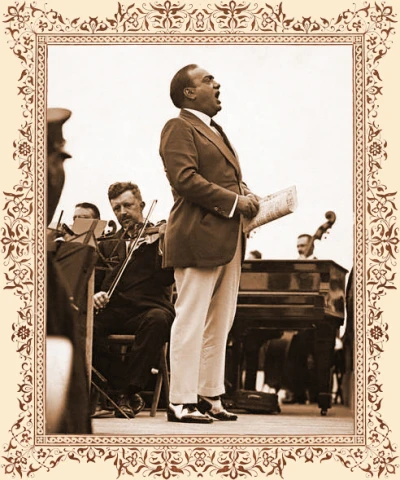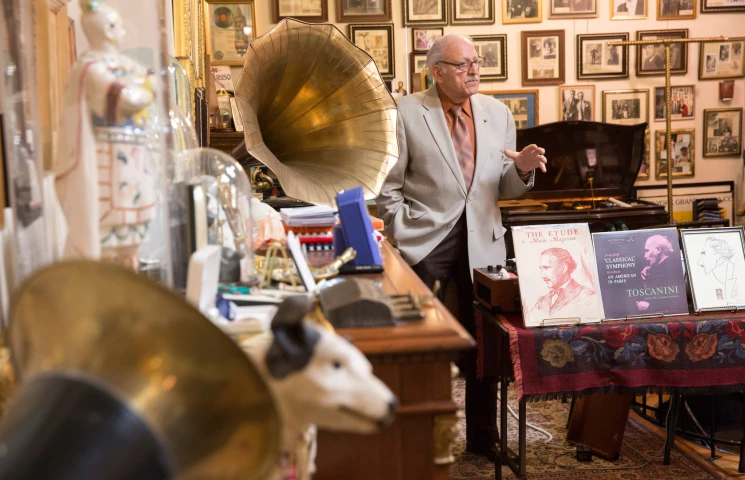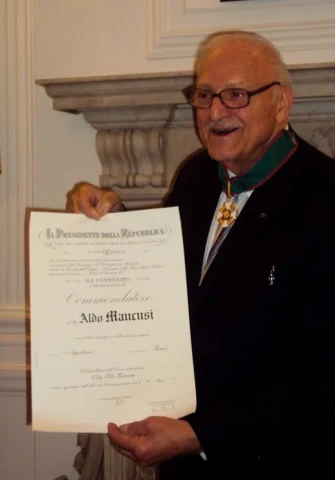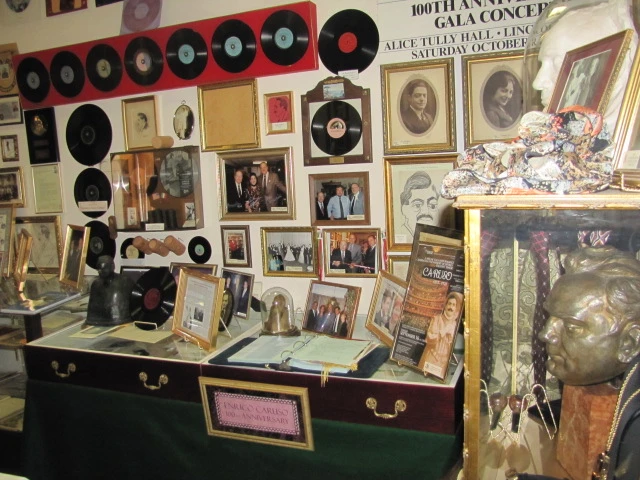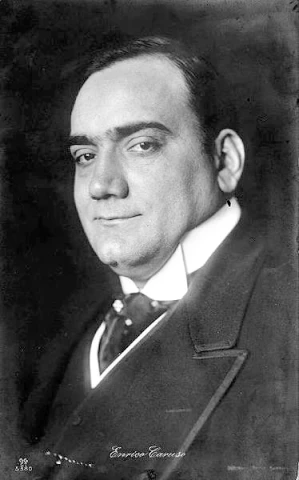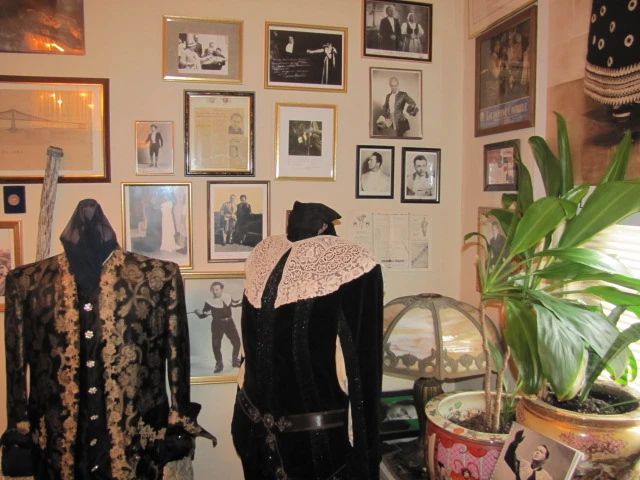Imagine years of discrimination, without hope of being recognized of being worthy of any respect, possibly far from your family left in your homeland, working two or even three jobs, living in very poor conditions. Then, imagine a moment of pride, a glimpse of revenge, a situation where not only your people are respected, but one of them is hero, a celebrity, a leader cherished and admired in the whole world.
That is what happened when Enrico Caruso arrived to the US. From then on, he would be the most important, popular and successful living artist in the world. New York celebrates Enrico Caruso: in Brooklyn there's a museum that was imagined, created and still is directed by a pioneer, a visionary, an enthusiast for Caruso like nobody else. His name is Aldo Mancusi, and we are very happy to talk with him
Aldo who was Enrico Caruso, and why has he been so important for the Italians all over the world and in particular in America?
When Enrico Caruso first came to America in 1903, to perform at the Metropolitan Opera House, most Italians were not educated. They came from Southern Italy to America for a better life. So, he brought so much prestige to Italians and so much culture to the New York area that people looked up to him when he performed. Many Italians would go to the Met, in the standing room only, so they did not pay for the seat. That is how he uplifted the Italian community, he was the first one who did that, because everyone loved Caruso, in America and all over the world. I've got people coming to the museum from China, Korea, Australia, Canada, and especially from South America.
When did Caruso start recording, and when did he come to the US?
In the beginning, his first ten recordings were done through the Gramophone & Typewriter Company based in London. They were all, recorded by the Gaisberg brothers, in Milan, Italy.
When Caruso demanded 500 dollars for the recordings, the company back in London radioed them a telegram: "Do not record Caruso. The fee is ridiculous", because if they sold 25 or 50 or 100 records they would never make their money back. But they did know the talent of Caruso, and so they took the deal. When those ten first recordings were released they didn't sell 100, they sold thousands: so much that in November of 1902 the London company paid the Gaisberg brothers five hundred thousand dollars in advance and said: "Please, try to get Caruso again". And they did: that's when the recording industry became very popular it was all because of Caruso who literally made the record business boom.
When he came to America in 1903 he exclusively recorded for the Victor Record Company. Right upon the time he died, on August 2nd 1921, those records became his treasures, the legacy that he left to the public. The Victor Record Company made millions of dollars and in 1929 was sold to RCA Radiola Company. Today the Caruso family is still receiving royalties from the records sale.
How did you have the idea to open the Enrico Caruso Museum?
My parents were not citizens: I was born Italian and my first language is Neapolitan. My father came from a town called Sarno, near Salerno, while my mother came from Gragnano, near Naples. Both came in 1920 and they didn't know each other. They met here, got married and had six children. My father loved Caruso and played the piano, while my mother sang at all church services, not professionally, but certainly for every family gathering. So, they were both fans, and also all the children. My father had about 70 records of Caruso and a collection of about 300 opera records.
My father also had memorabilia, and there was a gentleman, who I got pretty friendly with, who knew Caruso. His name was Michael Sisca, and he had worked with "La Follia di New York", an Italian newspaper in New York. His father Marziale Sisca was a very close friend to Caruso, who would send him caricatures, for the 17 years that Caruso lived in America, and Sisca would put them in his newspaper. When he accumulated a hundred he put them in a book form.
"La Follia di New York" was very popular, because there were many immigrants here: the newspaper was put out by Marziale and Alessandro Sisca, who was a play writer and wrote the lyrics of many songs, one of them being "Core 'ngrato", under the name of Cordiferro. The whole idea of building a museum came from Michael Sisca when he saw my huge collection; and as he had a huge collection too, he said "Aldo, if you open up this museum I will give you all my artifacts when I pass away". So, in 1982 I opened up the museum in one thousand square feet above my living quarters. We are officially registered with the State Education department as a cultural center.
It took a few years to get the people coming: we've had thousands of people come by and many movies were done here.
Which are the most important memorabilia people can find in your museum?
We purchased the Caruso bust from Enrico junior, and we also bought the jewelry that Caruso purchased for his first mistress, Ada Zacchetti. We also have donations from Michael Sisca: Caruso's tights, his cigarette box with cigarettes inside, a fork and spoon that he had with, cheques that Caruso signed, and sixty original caricatures signed by Caruso, which are priceless. We have the walking stick he used; and we have many original letters that he wrote to many people; and we have his death mask. When Caruso died, the only one that was allowed to touch him was Cifariello, a sculptor that did two busts for him in 1911 and was a very good friend of Caruso's. So when he died, Cifariello was allowed to make a mask of Caruso, out of wax, and from that he made the plaster face of Caruso when he was lying on his pillow.
But, the most important item that we have here, which has never been published and is now coming out in my new book which will be hopefully out by the end of the year, is a picture which is very important because it is, in fact, the last picture of Caruso. He died 15 days after this last picture, and he was only 48 years old.
There's a whole book written by his wife, his second love, Dorothy Benjamin, about his illness and why the doctors here did not want him to go to Italy. But he wanted to go back to Naples, he always said: "I want to die in my hometown": and he died in Naples, where he was born.
You know, recently we did an exhibition in Naples. I spent 35 years trying to get the people of Naples to build a museum for Caruso. They have a big city with thousands and thousands of citizens and tourists who all know Enrico Caruso, and Naples doesn't have a museum for someone like him who was born, sang, died and is buried there. It's ridiculous.
Caruso was a very generous person, right?
I have different documentaries where greatest opera singers and directors say that Enrico Caruso was the best, the number one singer in history: the greatest ever, either on and off stage.
I have one of a series of coins that he himself had minted from Tiffany's: he handed them out to people, just to be friendly and kind. And there are many similar stories.
I already told that "La Follia di New York" was printing all these caricatures made by him: so the editor of the New York Herald went to Caruso and said "We will give you 12,000 dollars a year (which was a lot, at that time) if you give us one caricature a month". Caruso said "I can't do that. I give my all caricatures to Marziale Sisca". And then they said "How much does Sisca pay you?"; and Caruso answered "He's my friend, he pays me nothing". He had a Neapolitan heart. Always joking, happy, he used to say: "I may have been hungry at times but I was never unhappy as long as I was singing".
What's your favorite song from his repertoire?
"Vesti la giubba", from "I Pagliacci". There are many, but that really shows Caruso's talent. But he was special even out of the opera singing: no one could ever sing "Core 'ngrato" like he did. Professionals told me that no singers today could sing like him this particular aria. They all said to me: "Aldo, this is impossible, he sang all phrases without taking a breath."
Immaginate anni di discriminazione, senza speranza di vedersi riconosciuto alcun rispetto, lontani da casa e probabilmente dalla vostra famiglia rimasta in patria, facendo due o anche tre lavori, vivendo in pessime condizioni: questa era la vita della la maggioranza degli italiani emigrati alla fine del XIX secolo negli Stati Uniti. E poi immaginate un momento di orgoglio, un lampo di rivincita, una situazione in cui non solo vedere riconosciuto il vostro popolo, ma in cui un italiano come voi sia visto e acclamato come un eroe, una celebrità, un leader amato e ammirato in tutto il mondo.
Questo è ciò che accadde quando Enrico Caruso arrivò negli Stati Uniti: da quel momento in poi sarebbe stato l'artista vivente più importante, popolare e di successo al mondo. Naturalmente, New York celebra Enrico Caruso: a Brooklyn c'è un museo che, come altri che già abbiamo descritto, è stato immaginato e creato e ancora oggi è diretto da un pioniere, un visionario, qualcuno appassionato di Caruso come nessun altro: il suo nome è Aldo Mancusi, e noi siamo molto felici di parlare con lui oggi
Aldo, prima di tutto: chi era Enrico Caruso, e perché è stato così importante per gli italiani di tutto il mondo ed in particolare per gli italiani d'America?
Quando Enrico Caruso arrivò per la prima volta in America nel 1903, per esibirsi al Metropolitan Opera House, la maggior parte degli italiani non erano molto colti. Erano arrivati dal sud dell'Italia in America per una vita migliore. Così, Caruso portò tanto lustro agli italiani e tanta cultura per l'area di New York, e la gente lo riconobbe come un leader quando si esibiva. Molti italiani, tra cui i miei nonni e mio padre, andavano al Met ad assistere alle sue esibizioni, ma nei posti in piedi; erano posti gratuiti, ed è così che Caruso aiutò la comunità italiana a risollevarsi, perché tutti amavano Caruso. Tutti quelli che lo ascoltavano naturalmente ne ammiravano la sua voce e la sua personalità: perché non solo era un grande tenore e un grande artista, ma era anche una grande persona ed era molto amato da tutti coloro che lo conoscevano.
Quindi, devo dire che è stato il primo a dare motivo per una rivincita alla comunità italiana in America. Ed era amato in tutto il mondo, non solo qui. Ho persone che vengono al museo da Cina, Corea, Australia, Canada, in particolare dal Sud America ed è incredibile come tutto il mondo conosca il nome di Enrico Caruso.
Quando ha cominciato a registrare Caruso, e quando è venuto negli Stati Uniti?
In principio, le sue prime dieci registrazioni furono fatte grazie alla Gramophone Company & Typewriter con sede a Londra, e tutte le registrazioni furono effettuate a Milano, dai fratelli Gaisberg. Quando giunsero dall'America a Londra per migliorare i loro sistemi di registrazione, furono inviati a Milano per registrare qualcuno dal mondo dell'opera. E dissero: "Dobbiamo registrare il signor Caruso".
Quando Caruso chiese cinquecento dollari per le registrazioni, l'azienda inviò un telegramma dicendo "Non registrate Caruso. Chiede un prezzo ridicolo per quanto è alto": perché se avessero venduto 25 o 50 o 100 copie non sarebbero mai riusciti ad avere un profitto. Ma i fratelli Gaisberg conoscevano il talento di Enrico Caruso, e così fecero l'affare. E così, quando furono pubblicate quelle prime dieci registrazioni, non vendettero 100 copie ma ne vendettero migliaia: tanto che nel novembre del 1902 la società di Londra pagò i fratelli Gaisberg cinquecentomila dollari in anticipo dicendo loro: "Per favore, cercare di fare altre registrazioni di Caruso". E lo fecero: fu in quel momento che l'industria discografica divenne molto popolare, per merito di Caruso che fu colui che letteralmente provocò il boom del business discografico.
Quando arrivò in America nel 1903, Caruso iniziò ad incidere in esclusiva per la Victor Record Company. Fino alla sua morte, che avvenne il 2 agosto 1921, i suoi dischi divennero la sua ereditò, il suo tesoro lasciato al suo pubblico. La Victor Record Company guadagnò milioni e milioni di dollari, e nel 1929 fu venduta alla RCA Radiola Company: e oggi, da quello che so, la famiglia Caruso continua a ricevere royalties dalle vendite.
Come hai avuto l'idea di aprire l'Enrico Caruso Museum?
I miei genitori non erano cittadini americani: io sono nato italiano e la mia prima lingua è il napoletano. Quindi io non parlo italiano, parlo il dialetto. Mio padre veniva da Sarno, in provincia di Salerno, mentre mia madre veniva da Gragnano, in provincia di Napoli. Entrambi arrivarono nel 1920 e non si conoscevano. Si incontrarono qui e si sposarono e ebbero sei figli. Mio padre amava Caruso e la musica in generale, e suonava il pianoforte, mentre mia madre andava sempre in chiesa dove cantava, e lo faceva anche in tutte le feste e nelle riunioni di famiglia. Così erano entrambi fan, e lo eravamo anche noi bambini, io in particolare: tutti molto appassionato di opera e di Caruso, naturalmente. Mio padre aveva circa 70 dischi di Caruso e una collezione di più di 300 dischi d'opera.
Mio padre aveva anche cimeli, e poi c'era un amico che frequentavo che conosceva Caruso. Il suo nome era Michael Sisca, e aveva lavorato con "La Follia di New York", un quotidiano italiano a New York. Suo padre Marziale Sisca era molto amico di Caruso: l'artista gli mandava sempre le caricature che disegnava, per tutti i 17 anni che Caruso visse in America; e Sisca le pubblicava nel suo giornale, e quando ne accumulò un centinaio le raccolse in un libro.
"La Follia di new York" era molto popolare, perché c'erano moltissimi emigrati italiani: il giornale era pubblicato da Marziale e Alessandro Sisca, che era un autore che scrisse le parole di molte canzoni, una delle quali è "Core 'ngrato ", con lo pseudonimo di Cordiferro. Così, l'idea di aprire un museo venne a Michael Sisca quando vide la mia vasta collezione; e siccome anche lui ne aveva un'altra molto ricca, mi disse "Aldo, se tu apri questo museo io prometto che quando morirò ti donerò tutti gli oggetti della mia collezio0ne". Così, aprii il museo di circa 300 metri quadri, al piano superiore a quello della mia abitazione. Questo avvenne più di 30 anni fa, nel 1982. Siamo ufficialmente registrati come un centro culturale presso il dipartimento statale per l'istruzione, e abbiamo una fondazione che collabora con il museo.
All'inizio ci vollero alcuni anni per essere conosciuti e cominciare ad avere una clientela: ma poi iniziammo ad avere migliaia di visitatori, e diverse scene di molti film sono state girate qui, per cui siamo diventati abbastanza noti. Per il nostro 25 ° anniversario abbiamo organizzato un bel concerto di Marcello Giordani. Marcello è venuto a visitarci e si è innamorato del museo, e si è offerto di cantare: naturalmente nel corso degli anni abbiamo organizzato molti concerti qui, incluso quello con Riccardo Caruso da Viareggio, che è il pronipote di Enrico Caruso e canta presso il Teatro dell'Opera di Firenze.
In questi anni avete sviluppato diverse attività e programmi riguardanti la storia di caruso, sia negli Stati Uniti che in Italia. Ci dici qualcosa in più su questo?
Abbiamo fatto molte, molte cose presso la comunità italiana in America e anche in Italia, dove abbiamo organizzato ben 14 mostre. Per questo motivo 17 anni fa mi è stato conferito il titolo di Cavaliere, e proprio lo scorso giugno ho ricevuto anche il titolo di Commendatore. E' stato un grande onore per me essere decorato dal governo italiano per qualcosa che amo fare.
In America, naturalmente, abbiamo avuto diverse mostre in molti posti, e io ho tenuto e tengo lezioni sia al museo che in moltissime scuole ed università nella zona di New York, su Caruso ma anche, in generale, sull'opera italiana: così parlo anche di Pavarotti, Toscanini, Puccini, Verdi e tutti i grandi cantanti, direttori d'orchestra e compositori italiani.
Quali sono gli oggetti più importanti presenti nel vostro museo?
Abbiamo acquistato il busto di Enrico Caruso da suo figlio, e abbiamo comprato anche i gioielli che Caruso acquistò per la sua prima amante, Ada Zacchetti. Abbiamo anche ricevuto le donazioni dalla collezione di Michael Sisca: il frac di Caruso, il suo portasigarette ancora pieno, una forchetta e cucchiaio che portava sempre con lui, assegni firmati da lui, e sessanta caricature originali firmati da Caruso, che assolutamente hanno un valore inestimabile. Abbiamo il suo bastone da passeggio, e abbiamo molte lettere originali scritte e firmate da lui; e poi abbiamo la sua maschera mortuaria.
Cos'è?
Quando Caruso morì, l'unico a cui fu permesso di toccarlo fu Cifariello, uno scultore che aveva già scolpito due busti per lui nel 1911 e gli era molto amico. Così, quando Caruso morì, a Cifariello fu permesso di fare una maschera di Caruso, sulla cera, e da quella ricavò il gesso del viso di Caruso, sdraiato sdraiato sul suo cuscino. Questa è la maschera mortuaria di Caruso.
Ma, l'elemento più importante che abbiamo qui, che non è mai stato pubblicato e lo sarà per la prima volta nel mio nuovo libro che sarà pronto entro la fine dell'anno, è una fotografia che è molto importante perché è l'ultima immagine di Caruso. Morì 15 giorni dopo questa ultima immagine.
È morto giovane ...
Sì, aveva solo 48 anni. C'è un libro scritto da sua moglie, il suo secondo amore Dorothy Benjamin, che racconta tutta la storia della sua malattia e perché i medici americani non volevano che lui andasse in Italia, ma che rimanesse qui. Ma lui voleva tornare a Napoli, diceva sempre: "Voglio morire nella mia città": ed infatti è morto a Napoli, dove era nato.
Sai, di recente abbiamo fatto una mostra a Napoli. Io da 35 anni cerco di convincere la gente di Napoli a mettere in piedi un museo su Enrico Caruso. In una grande città come Napoli, con migliaia e migliaia di cittadini e turisti ognuno dei quali sa chi sia stato Caruso, non c'è un museo per uno come lui che è nato, ha cantato, è morto ed è sepolto a Napoli. È ridicolo.
A parte Napoli, c'è un Museo su Enrico Caruso in Italia?
Sì, c'è un museo a Lastra a Signa, in provincia di Firenze, che è una casa trasformata in un museo.
Caruso era una persona molto generosa, giusto?
Ho diversi documentari in cui tutti i più grandi cantanti lirici e direttori d'orchestra dicono che Enrico Caruso è stato il migliore cantante nella storia, il numero uno: ma non solo sul palco, anche nella vita.
Nella mia collezione ho una moneta che faceva parte di una serie di monete che lui stesso aveva coniato da Tiffany, per poi distribuirle alla gente, per un gesto di pura e incondizionata cortesia. E ci sono molte, molte storie che raccontano la sua generosità. Una molto importante è questa. Come detto, "La Follia di New York" stampava tutte queste caricature disegnate da lui: per cui l'editore del New York Herald andò da Caruso e gli disse "Ti daremo 12.000 dollari l'anno (che era molto, a quel tempo), se ci fai una caricatura al mese ". Caruso disse: "Non posso farlo. Io do tutte le mie caricature a Marziale Sisca per La Follia di New York". E quando loro chiesero "Quanto ti paga Sisca?", Caruso rispose "E' un mio amico, non mi paga nulla".
Questo è tipicamente italiano
E' quello che sto cercando di dire, aveva un cuore italiano, o meglio un cuore napoletano. Sempre allegro e felice, molte volte disse "A volte posso aver fatto la fame, ma finché potrò cantare non sarò mai infelice". Così, da giovane lui a volte patì veramente la fame, e la sua famiglia non aveva certo la possibilità di avere i migliori vestiti; ma sicuramente amava quello che stava facendo, era un uomo felice. Quindi queste sono le cose che sono veramente importanti da conoscere per il pubblico, e tutte queste storie e ancora altre saranno nel mio nuovo libro.
Qual è l'aria di Enrico Caruso che preferisci?
"Vesti la giubba", da "I Pagliacci". Ce ne sono davvero tante, ma credo che in realtà questa racconti il talento di Caruso perché quando canta in quell'aria sta letteralmente piangendo. Ma lui era speciale anche al di fuori del canto lirico: non c'è nessuno a questo mondo che potrebbe mai cantare "Core 'ngrato" come ha fatto lui. Il suo talento e le sue capacità erano sorprendenti. Molti professionisti mi hanno detto non ci sono cantanti che oggi potrebbero cantare questa particolare aria senza prendere fiato. Tutti mi dicono: "Aldo, questo è impossibile, ha cantato tutte le frasi senza prendere fiato". E' incredibile quanto fosse così potente, così forte.
Qual è il futuro dell'Enrico Caruso Museum?
Abbiamo diverse offerte, e una cosa che vogliamo fare è di trasferire il museo a Manhattan, perché oggi siamo a Brooklyn. Abbiamo già avuto diverse riunioni, e questo è quello che vogliamo: che si espanda e che arrivi a Manhattan, con l'intera collezione, a condizione che sia garantita l'apertura 365 giorni all'anno e che ci si assicuri contro qualsiasi problema; e, nel caso che un giorno l'interlocutore non voglia più la raccolta, che questa torni ai miei eredi. E' la mia eredità, ho lavorato per decenni su questa collezione e voglio che in futuro le persone di tutto il mondo siano in grado di apprezzare ciò che mi ho apprezzato io negli ultimi 50 anni. Mio padre, che se n'è andato, molti anni fa, amava avere i suoi dischi in mostra: quindi per me è una cosa di famiglia.


